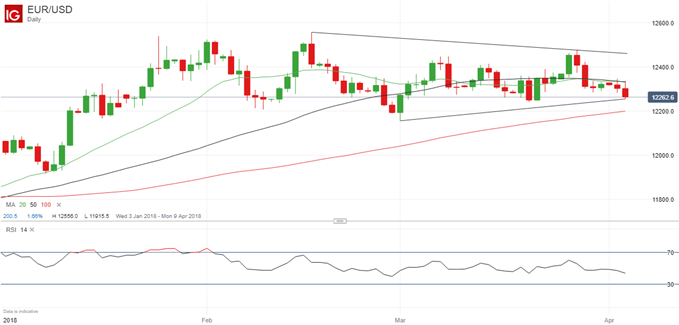EUR TALKING POINTS:
- Euro-Zone consumer prices are expected to have risen by 1.4% year/year in March, up from 1.2% in February.
- That should keep an eventual increase in interest rates by the European Central Bank in focus and support the Euro.
TRADING THE NEWS: EURO-ZONE INFLATION

Euro-Zone inflation data for March are due at 0900 GMT today and are expected to show a 1.4% year/year increase in consumer prices, up from 1.2% year/year in February. Euro-Zone interest rates are unlikely to be hiked until around the middle of next year or even later but a move nearer to the European Central Bank’s target of “below, but close to, 2%” should still support the Euro.
The numbers will be released after a relatively subdued period of trading for EUR/USD despite concerns about a possible trade war between the US and China, as well as weakness in US technology stocks, that have damaged business confidence.
EURUSDPRICE CHART, DAILY TIMEFRAME (JANUARY 1 – APRIL 3, 2018)

For longer-term predictions, take a look at our Q2 forecasts for the major currency pairs, gold, oil and equities.
The impression that the Euro-Zone economy is growing robustly should be underlined by labor-market data, also due for release at 0900 GMT, that are expected to show a fall in the unemployment rate to 8.5% in February from 8.6% in January. On Thursday, final Euro-Zone purchasing managers’ indexes for the Euro-Zone in March and retail sales data for the area in February should paint a similar picture. Note too that German inflation figures have already shown an increase to 1.5% from 1.2%, boosted by the volatile food and energy components.
As for the ECB, it has already reduced its asset-purchase program and is likely to wind it down further this year ahead of possible interest rate increases in 2019. While Germany continues to press for higher rates – perhaps around the middle of next year – others on the ECB’s rate-setting General Council have been more dovish so it remains too early to put a likely date on the expected rate rise.
EURUSD levels to watch out for
Returning to the EURUSD chart, the key levels to watch out for on the upside are the March 27 high at 1.2477 and the February 16 high at 1.2566. To the downside, the key support is at the March 1 low of 1.2154.
Interestingly, while last week’s German inflation numbers were weaker than predicted, an initial fall in EUR/USD was followed quickly by a rally, suggesting that even disappointing Euro-Zone data could be see any initial move lower reversed.
EURUSDPRICE CHART, FIVE-MINUTE TIMEFRAME (MARCH 29, 2018)

Check out the IG Client Sentiment data to help you trade profitably.
If you’d like to learn how to trade like an expert, you can read our guide to the Traits of Successful Traders. Some of the key lessons are:
- Successful traders cut losses, and let profits run,
- Successful traders use leverage effectively, and
- Successful traders trade at the right time of day.
For more help to trade profitably listen to our regular Trading Webinars.
--- Written by Martin Essex, Analyst and Editor
Feel free to contact me via the comments section below, via email at martin.essex@ig.com or on Twitter @MartinSEssex







